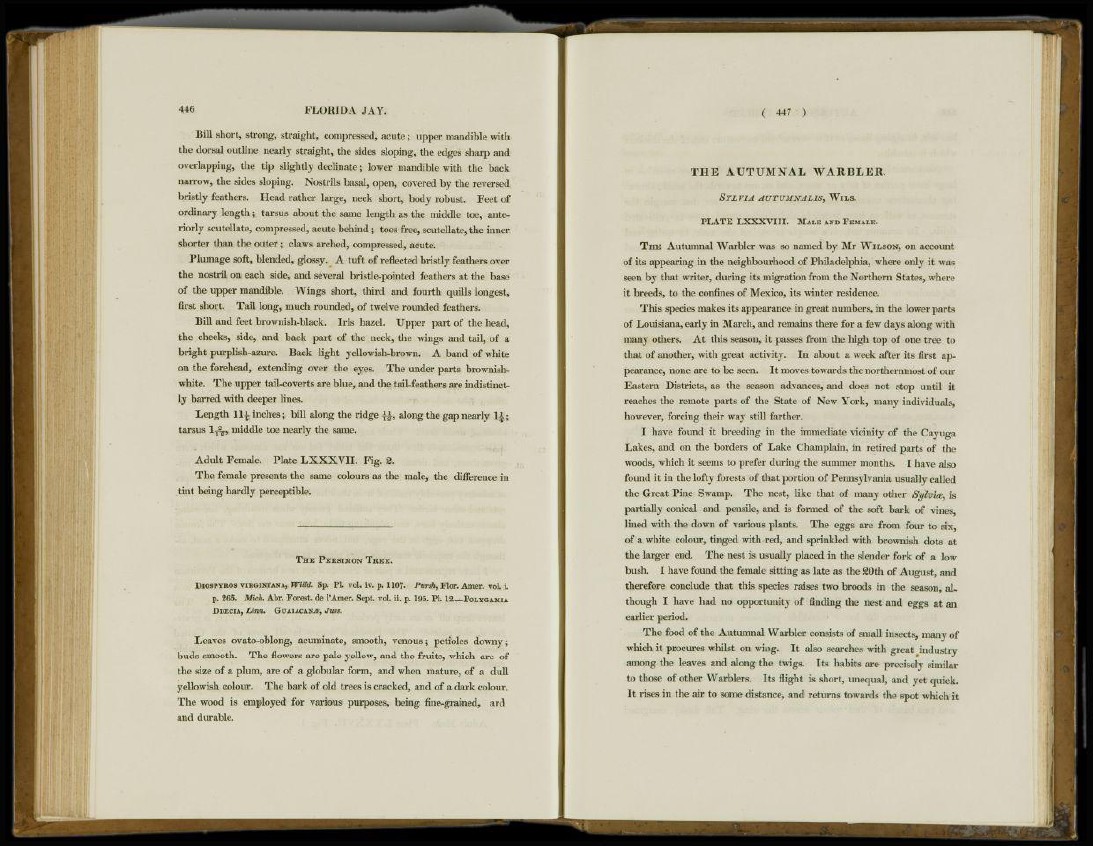
446 FLORIDA JAY.
Bill short, strong, straight, compressed, acute; upper mandible with
the dorsal outline nearly straight, the sides sloping, the edges sharp and
overlapping, the tip slightly declínate; lower mandible with the back
narrow, the sides sloping. Nostrils basal, open, covered by the reversed
bristly feathers. Head rather large, neck short, body robust. Feet of
ordinary length; tarsus about the same length as the middle toe, anteriorly
scutellate, compressed, acute behind ; toes free, scutellate, the inner
shorter than the outer; claws arched, compressed, acute.
Plumage soft, blended, glossy. A tuft of reflected bristly feathers over
the nostril on each side, and several bristle-pointed feathers at the base
of the upper mandible. Wings short, third and fourth quills longest,
first short. Tail long, much rounded, of twelve rounded feathers.
Bill and feet brownish-black. Iris hazel. Upper part of the head,
the cheeks, side, and back part of the neck, the wings and tail, of a
bright purplish-azure. Back fight yellowish-brown. A band of white
on the forehead, extending over the eyes. The under parts brownishwhite.
The upper tail-coverts are blue, and the tail-feathers are indistinctly
barred with deeper fines.
Length 114; inches; bill along the ridge | £ , along the gap nearly 1£;
tarsus middle toe nearly the same.
Adult Female. Plate LXXXVII. Fig. 2.
The female presents the same colours as the male, the difference in
tint being hardly perceptible.
THE PERSIMON TREE.
DIOSPYROS VIRGINIAN A, Willd. Sp. PI. vol. iv. p. 1107. Purslt, Flor. Amer. vol. i.
p. 265. Mich. Abr. Forest, de PAmer. Sept. vol. ii. p. 195. PI. 12. POLYGAMIA
DM:CIA, Linn. GUAIACANS, Jttss.
Leaves ovato-oblong, acuminate, smooth, venous; petioles downy;
buds smooth. The flowers are pale yellow, and the fruits, which are of
the size of a plum, are of a globular form, and when mature, of a dull
yellowish colour. The bark of old trees is cracked, and of a dark colour.
The wood is employed for various purposes, being fine-grained, ard
and durable.
( 447 )
T H E AUTUMNAL WARBLER.
SYLVIA AUTUMNALIS, WILS.
P L A T E L X X X V I I I . MALE AND FEMALE.
THE Autumnal Warbler was so named by Mr WILSON, on account
of its appearing in the neighbourhood of Philadelphia, where only it was
seen by that writer, during its migration from the Northern States, where
it breeds, to the confines of Mexico, its winter residence.
This species makes its appearance in great numbers, in the lower parts
of Louisiana, early in March, and remains there for a few days along with
many others. At this season, it passes from the high top of one tree to
that of another, with great activity. In about a week after its first appearance,
none are to be seen. It moves towards the northernmost of our
Eastern Districts, as the season advances, and does not stop until it
reaches the remote parts of the State of New York, many individuals,
however, forcing their way still farther.
I have found it breeding in the immediate vicinity of the Cayuga
Lakes, and on the borders of Lake Champlain, in retired parts of the
woods, which it seems to prefer during the summer months. I have also
found it in the lofty forests of that portion of Pennsylvania usually called
the Great Pine Swamp. The nest, like that of many other Sylvia, is
partially conical and pensile, and is formed of the soft bark of vines,
lined with the down of various plants. The eggs are from four to six,
of a white colour, tinged with red, and sprinkled with brownish dots at
the larger end. The nest is usually placed in the slender fork of a low
bush. I have found the female sitting as late as the 20th of August, and
therefore conclude that this species raises two broods in the season, although
I have had no opportunity of finding the nest and eggs at an
earlier period.
The food of the Autumnal Warbler consists of small insects, many of
which it procures whilst on wing. It also searches with great industry
among the leaves and along the twigs. Its habits are precisely similar
to those of other Warblers. Its flight is short, unequal, and yet quick.
It rises in the air to some distance, and returns towards the spot which it